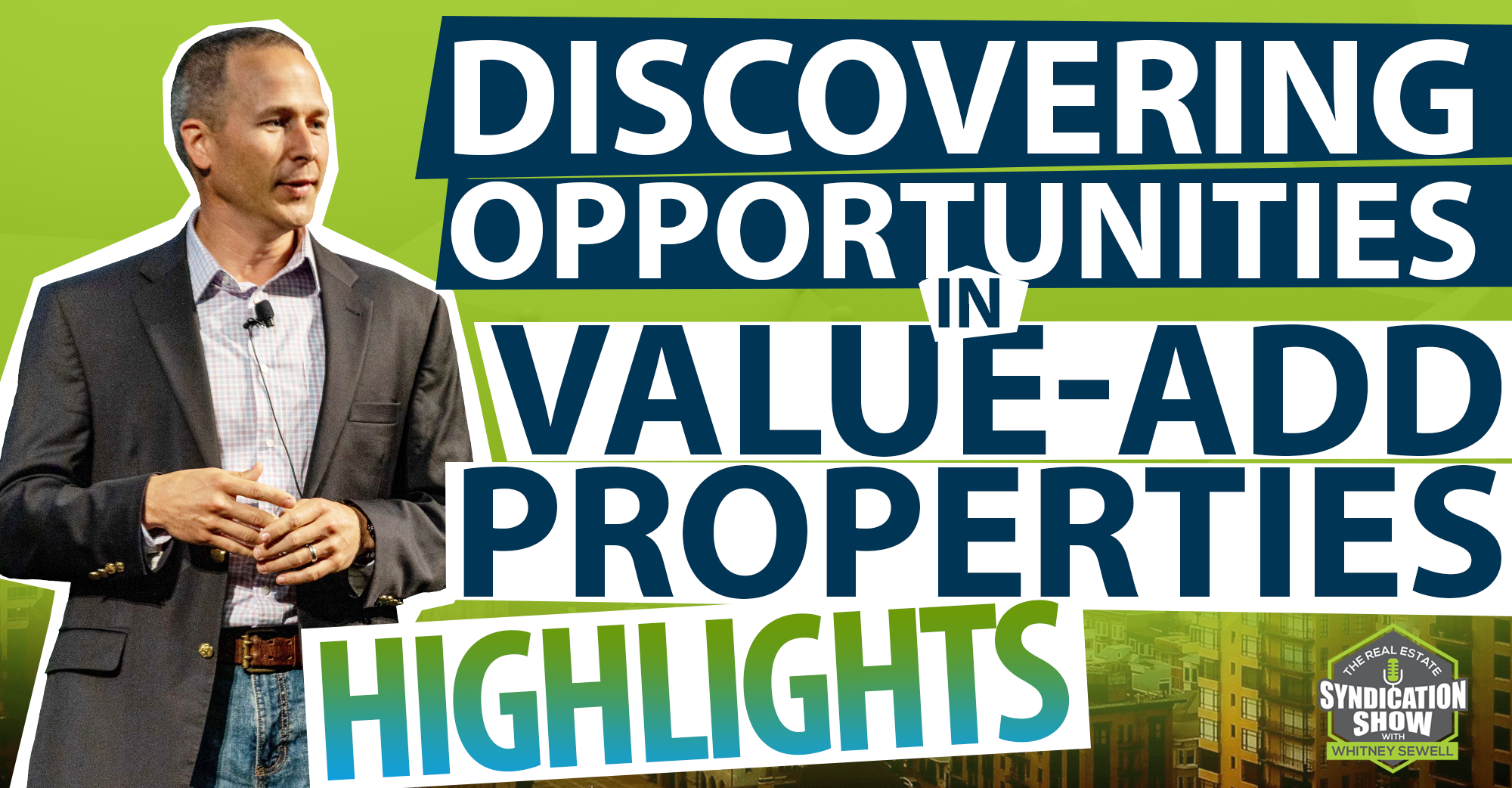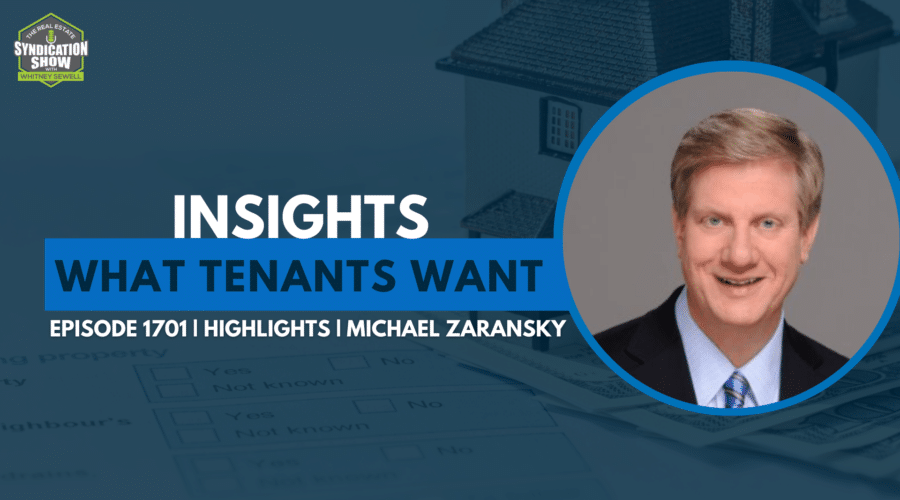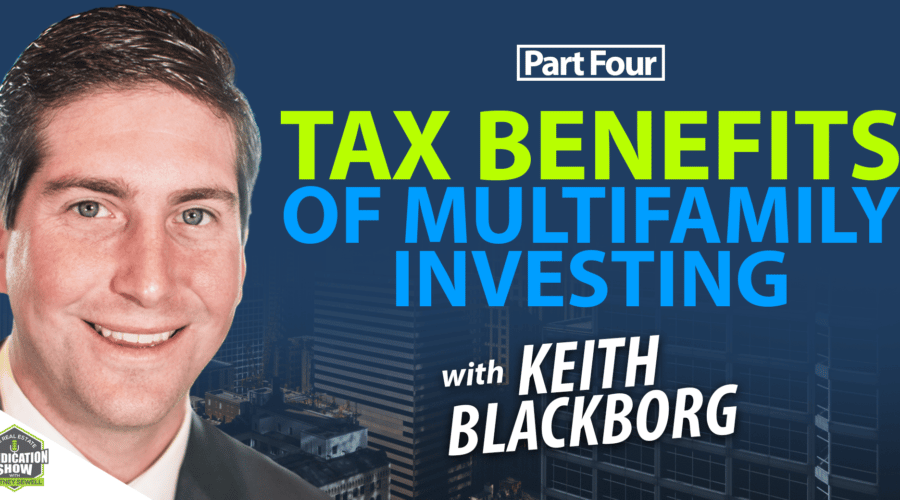There are a lot of opportunities waiting to be discovered especially if you know how to have value-add properties. In this Highlights episode, we look back at our conversations with Chris Grenzig of Toro Real Estate Partners and Paul Moore of Wellings Capital. They talk about how to discover opportunities in value-add properties!
Watch the episode here:
Listen to the podcast here:
Chris reveals how a focused investing approach can help you syndicate value-add deals that can generate handsome ROI’s with minimal risk for you and your investors. While Paul shares some great tips for syndicators who are finding it difficult to discover value-add opportunities in this liquidity-fueled market. Tune in as we share some investing gems you need to know right now!
Key Points From This Episode:
- How did Chris find and finance his first 82-unit deal in Jacksonville?
- Reasons why Chris decided to go ahead with the Jacksonville deal.
- What sort of changes did Chris make to the 82-unit property to drive greater value?
- Why Jacksonville is a strategic location for real estate investors.
- Chris espouses the deal structure for the 82-unit property.
- Chris’s plans for renovating the Jacksonville property, driving up rents, and then profitably exiting
- Paul shares how he managed to add 10% to the bottom line by fixing leaks on his last syndication deal
- Why did Paul choose to let go of the opportunity to invest in a 130 unit property in Knoxville, Tennessee?
- Five reasons why syndicators are willing to overpay in current market conditions
- How do investors react to Paul letting so many deals pass by?
- Paul explains why the immense value add opportunities make self-storage such a good investment
Tweet This!
“I think the important factor that people need to realize is it’s really hard to do the syndication business without the money already in your pockets.” — Chris Grenzig
“The perfect investment is no longer perfect if you don’t find any deals.” — Paul Moore
“There’s a lot of opportunities to get. You wouldn’t think that value-add is something you could do in self-storage, but you actually can. There are a lot of things that can be done.” — Paul Moore
Links Mentioned in Today’s Episode:
WS103: How to Syndicate Value Add Properties with Chris Grenzig
WS37: How to Discover Value Add Opportunities in a Hot Real Estate Market with Paul Moore
About Chris Grenzig
Chris started real estate in January 2016 by trying and failing at house flipping and purchasing tax deeds, but eventually found his footing in multifamily real estate. From 2016-2020, he joint ventured on 100 units and worked as the director of the Florida portfolio for Toro Real Estate Partners which acquired 4000 units worth $300m during his time there. In November 2020, Chris left Toro to start his own company JAG Communities, based in Jacksonville, FL which is an owner-operator focused on multifamily real estate with 40 units worth $3m currently owned and a 10-year vision to scale to $500 million in assets under management.
About Chad Hudson
After graduating with an engineering degree and then an MBA from Ohio State, Paul Moore started on the management development track at Ford Motor Company in Detroit. After five years, he departed to start a staffing company with a partner. They sold it to a publicly traded firm for $2.9 million five years later. Along the way, Paul was Finalist for Ernst & Young’s Michigan Entrepreneur of the Year Award two years straight. Paul later entered the real estate sector, where he completed 85 real estate investments and exits, appeared on an HGTV Special Real Estate episode, rehabbed and managed dozens of rental properties, developed a waterfront subdivision, and started two successful online real estate marketing firms. Three successful developments, including assisting with the development of a Hyatt hotel and a multifamily housing project, led him into the multifamily investment arena. Paul co-hosts a wealth-building podcast called How to Lose Money and is a writer for BiggerPockets. Paul is the author of The Perfect Investment–Create Enduring Wealth from the Historic Shift to Multifamily Housing.
Full Transcript
EPISODE 1091
[INTRODUCTION]
[0:00:01.6] ANNOUNCER: Welcome to The Real Estate Syndication Show. Whether you are a seasoned investor or building a new real estate business, this is the show for you. Whitney Sewell talks to top experts in the business. Our goal is to help you master real estate syndication.
And now your host, Whitney Sewell.
0:00:28.5
Whitney Sewell: This is your Daily Real Estate Syndication Show. I’m your host, Whitney Sewell. We hear the term all the time in our industry, value-add, the value-add real estate or value-add projects. And, that term is thrown around a lot.
But, there’s many different parts of a value-add business plan that we need to know about. Especially if you are a passive investor or if you’re an operator, you need to think about — is this a deep value-add? Is this a live value-add? How do we express that? How do we know what to do when we’re talking about a value-add type project?
I hope today you learn a lot from the Highlights from these shows and these operators talking about value-add projects. Have a blessed day!
[INTERVIEW 1]
00:01:00.0
Whitney Sewell: Our guess is Chris Grenzig. Thanks for being on the show, Chris.
0:01:06.3
Chris Grenzig: Yeah, thanks for having me.
0:01:07.3
WS: Why don’t we talk about, let’s say the 82-unit in Jacksonville. Why don’t you walk us through that deal a little bit.
0:01:12.9
CG: Yes, so that was actually a little bit more complicated in finding the deal because while we were working on some of the other stuff and I wasn’t quite working there, we started helping out with some of the meet-ups that we were doing. So we have been doing them and still do a free meet-up every month, and we kinda just center it around a different topic or a talking point, or will bring insurance.
0:01:34.9
WS: Where’s the meetup at?
0:01:35.9
CG: In Western New York on Long Island. So, while we were doing that, what we wanted to do was kind of do what we had done and do it with other people. So, we actually had, with the 17 units that we did in, it’s actually Covington, right outside Cincinnati. It’s like if you think about Brooklyn to Manhattan, Covington is the Brooklyn of Cincinnati across the water. A little bit different, a little bit smaller, but obviously not quite what we had in Brooklyn. And what we were able to do was we said to three people we said, we know who you wanna get to the space you wanna start buying stuff, invest with us, and we’ll sit down with you once a week, same type of thing. We’re not taking $20,000 for a coaching course, that’s not what we want.
But it was a business within a business, we were trying out to see if we liked it and if it would work, and we did it, we liked it, but it wasn’t something we really wanted to build out. So, we kinda just stopped it after that, but it actually led to one of the guys finding this deal in Jacksonville that we bought and brought it to us to partner with. So, it was a guy who was learning from us, myself, my mom, my cousin and John all partnered on the steel of different splits for different things, and we’re able to come in, raise the money from some private guys, people we knew from the meet and stuff like that. And then we actually also went out and raised the money with Realty shares, which is the crowd funding website.
It was interesting from that standpoint, the deal itself, the reason we really liked it was the manager that we know and have used in the past in Jacksonville, she was already managing the deal for the current owners. So, it was an easy transition, we called her up and said, Should we buy this? And she said, Yes. And then we went from there, obviously, it still made financial sense, and it’s probably one of our better performing deals, just ’cause we bought it right. And we knew how it was gonna operate. ’cause it was the same manager.
The only thing that really changed was taxes, and it was just a ton of upside on it, and the past owners came and then bought it, I mean, I see pictures and it was in pretty rough shape, and they actually did a really good job coming in and cleaning up and executing on their business plan and left their tremendous amount of meat on the bone for us, and it’s probably something that we’re still gonna be able to continue to increase renting income and still leave some on the bones for the next guy.
0:03:50.7
WS: What kind of upside? What will you all be changing, doing to the property to create this upside?
0:03:55.5
CG: Yeah, so we came in and we did some more cosmetic stuff, they did a lot with Rosas parking, a lot of stuff like that, where we came in and they had put up fences. Where we came in and we stand them a nice dark color, we came in and we finished putting in these black solar screen, which tied in well, ’cause there’s a lot of black outlining in the property. It’s tough to explain if you don’t see it, but I look a lot nicer. It also covers up the really bad lines that people break. It kinda hides that as well, which is nice when you’re driving through. The new pool furniture came in. What else did we do? A couple other extra things like securing some signage and landscaping, just minor stuff like that, and then we did a lot of interior upgrades, they had really, really old cabinets, flooring, appliances and stuff like that.
So, they had done a handful of a minor upgrade where they put in some final roll-outs and black appliances, they painted some cabinets, and what we were gonna do is come in and do the plank ’cause it a little bit easier to maintain new appliances, epoxy, the cabinet’s new hardware, new bath and bounties, new bathroom mirrors, re-service the counter, reservice tubs and just kind of spent like three to $3,500 per unit, push runs $100, $125 bucks.
Nothing crazy. And just kinda go from there. But one of the things that’s been really interesting is that the growth in Jacksonville has been incredible. In the past year, we’re 96% occupied, and we have a waiting list of more than one bedroom, which is crazy. And two is our manager is actually able to secure a deal with a local supplier for brand new cabinet brand and countertops for about $1,900 bucks installed, and it only brought up our cost about 1000 bucks per unit, where you were able to get another 50-75 bucks for that so it really changed what we were doing at the property and it really helped us be able to push Rensburg that we thought were gonna be able to.
0:05:44.1
WS: Nice, so tell us something else about this deal that you all like, go into the location a little deeper about Jacksonville.
0:05:52.1
CG: Jacksonville, fun fact, actually the largest land mass of any US city in a country. Back in the early 2000s, Deval county in the city of Jackson, it actually combined, basically combined and the same. So it’s actually the most amount of land of any US cities, so it’s always a fun fact, have you ever talked to somebody from Jacksonville especially in real estate, they always throw that in your face when you start talking to him about it.
So, I am always gonna throw that out there, but this is on the west side of Jacksonville, but the west side is probably one of the nicer areas. There’s really nice pockets in it, one of them is called Ortega, and ours is right just South Ortega, but just South for the west side, which is technically not in the city limits, is an area called Orange Park, Florida, which is a real B, C class area with some really nice properties, and we’re just south of Ortega and then north of Orange Park. So, we get a lot of benefits of both, and we were able to get it at a discount where you have the people that can’t quite live in Orange Park, and the people that can’t quite live in arta, but they want a nice place, and they were able to come to us and do get maybe not the nicest looking property from the exterior and doesn’t have all the liangshan is and all that stuff, but it’s just a bed place to live, big apartments being renovated and pretty solid workforce housing option for a lot of people.
0:07:08.5
WS: So, do you know about the structure of this deal, could you explain that to us? How much capital raise? How was it structured with investors?
0:07:17.6
CG: Yeah, sure, so it was just over $3.8 million. We came in and we got a small balance from Freddie. We got 80% loan to value. It was actually really nice. When we first got the property, he was like right around a 6 cap on trailing 12, and then the last two, three, four months, there was a really big uptick in income as they were finishing up their plan and putting all the last pieces into place. And by the time we closed, it was like a 6 and six and three-quarter cap before tax adjustments.
It was really nice going and we had a really nice delta on what we were borrowing money at and what our in-place cap rate was. So, we came in with really good cash flow coming in, and then on top of that, we brought about $350,000 in CAPEX to spend on a lot of the exterior stuff I said about.
A couple of little deferred maintenance items, they had some problems with likes and dungeons at some streams, we brought in some new soil to help get some stuff out, there’s actually a ditch around the exterior, the property behind the fencing where the water trails off too. So, we actually dug about a foot deeper and wider, and I cleared out a lot of dead trees and track and stuff like that to just help with the water off of the property, ’cause there’s some standing water when it rained pretty heavily and it rains a lot in Jacksonville. So we cleaned up some minor stuff like that, but a bulk of the capital has been towards interior renovations, and our plan was to come in and do, I think of the 80, we were gonna do about 45 of the units, give or take, doing the old upgrade plan.
But now we’re spending a little bit more, but we’re getting more in rent, so we’re probably gonna be doing a little bit less, probably in the upper 30s range, give or take, just because of the price to go up over again more. So, we’ll probably run a call for units give or take, and we’ll kinda just continue to push rent as much as we can cash flow and then look for an exit in a few years time.
0:09:10.6
WS: Awesome, Chris, changing directions a little bit. What advice would you give now, somebody that’s just getting into this business or wanting to get into the syndication business, maybe they’ve slipped a couple of homes or have a couple of single-family rentals, but now they say, Okay, I wanna scale this and do what you’re doing, what do you tell them?
0:09:27.2
CG: So, I think the important factor that people need to realize is — it’s really tough to do the syndication business without having some money already in your pocket. There’s a lot of things people don’t realize, especially if you’re gonna do out-of-state, there’s travel costs. There’s a cost to get the inspection done. There’s deposits. This money has to come from somewhere.
Now, obviously, you can go borrow at or have partners and this, that and the other… The other thing too is people to your non-recourse loan and they think, Oh, I don’t need to have millions of dollars in the bank, you still do have that have certain qualifications to be able to get 3, 5, 10 million loan even though it’s non-recourse, which some people don’t realize it, but it’s more of a common fact now. I feel like, especially in the syndication air pockets, real estate investing, the world, more people are starting to realize that.
So, I think a lot of that stuff people don’t realize until they start digging deeper and diving into it a little bit more that the world where you put no money down and you buy a 50 unit and you can kinda get seller financing for 95% of it and borrow the other 5% from friendly friends, I don’t know that it really exists anymore. There’s too much inter-connectivity and too many people that know what’s going on now. And a lot of those deals have sold, and it’s a lot tougher to find long-term owners that don’t know what they’re doing anymore, especially in some of the bigger metros with the million plus people and you’re talking to 100 units plus you go on in a 10-unit, that’s a different story.
But those kind of goals don’t exist. I think knowing that you’re gonna need money upfront and that there’s a very real chance you can lose money is something that a lot of people need to know.
[INTERVIEW 2]
0:10:57.8
WS: Our guess is Paul Moore. Thanks for being able to show, Paul.
0:11:00.8
Paul Moore: You bet. It’s great to be here. Whitney.
0:11:02.8
WS: Will you tell us a little bit about, maybe a recent deal that Wellings Capital did?
0:11:07.0
PM: Yeah, so I wrote a book called The Perfect Investment, and it’s about multifamily investing, and I feel a little weird about it now because the perfect investment is no longer perfect if you can’t find any deals. And as we record this here in the late summer of 2018, it’s very, very hard to find multifamily deals that make sense. I have friends looking for duplexes, they can’t find any to pencil out. I have friends with him for 300 units they have found with you, but not that many that work. And so it’s really hard.
So, we recently decided in the spring of 2018 to actually expand into self-storage, and there’s all kinds of reasons and metrics and demographics for why self-storage is a great investment right now, and if you ask me later in the show, I can get into that a little bit. But we actually decided, I’ve been studying more Warren Buffet and I’m actually writing a lot of articles for Bigger Pockets on Warren Buffets advice for real estate investors, and one thing he does really well is he doesn’t start companies from the ground up, he actually invests in other companies that have a successful product, they’re in a great location, etcetera. He throws money at them and helps those people grow.
And so, we decided that’s the way to get into self-storage for us. And so back in the spring, we took two trips to a storage companies headquarters, met with the CEO for many hours each time we went out and looked at about six of their deals. I actually went to Florida later and looked at a couple of their upcoming deals and we decided to tell our investors about that, and we invested with them.
So, our investors put together $29 million all into one check. We gave that check to the self-storage company and we invested in one of their deals. And so all of our investors are part of our one group investing in that company. So that’s my most recent deal, really excited to do more like that. We did a multifamily deal about nine months ago as well, and like in Kentucky, and one thing that’s really exciting about that is we found out at the very beginning of seeing that deal that they were spending way more than they needed to on water and sewer, over double what they should have been. And we realized they probably had a lot of leaks. We talked to a maintenance guy, and the pool they said was dropping, the water level was dropping about six or seven inches a day. And we said, Well, what are you doing about that? He said, Just fill her up every day. And so we thought, Oh, okay, good. That’s good, keep doing that.
So, we acquired this facility and we actually have been systematically fixing dozens and dozens of toilet flappers or whatever they’re called. And we fix the pool and we fix some other leagues, and so we’re bringing the water costs way down, water and sewer and gas costs as well. And so by doing that, we’re actually adding a significant, I think 10% to the bottom line. Now, when you take 10%, and this is another reason I love syndication, Whitney, if you take 10%, add it to the bottom line, but you’re leveraged at about 65% loan-to-value ratio, you just basically added about 30% to the leveraged bottom line. I’m just saying it that way, because when you divide your net income in a commercial deal by the cap rate, you will come up with the value… Okay, so if you can add $75,000 to your bottom line, you divide that by the current cap rate of, let’s say 7%, you’re adding something like a million dollars to the value of that property. And we did that for about a 65 or $75,000 investment. Where else can you get a return like that… Whitney, I ask you?
0:15:00.8
WS: Nowhere. Not that I know of.
0:15:02.8
WS: It’s true. So that’s one of the reasons we love syndication. One of the reasons why we love apartments. So if anybody has apartments called 1800. Now, seriously, call Whitney and let us know because we would love to acquire more multifamily.
0:15:19.5
WS: So, I mean, you talked a little bit about a deal that you all just put a bid in on, and we were gonna discuss that. Could you elaborate a little bit about what made that a deal you wanted to pursue even in this market? And why didn’t it turn out?
0:15:30.4
OM: Yeah, it was in Knoxville, Tennessee, and it was actually outside of not fill in a small town, and I didn’t have that much competition. It was built in 1984, if I’m not mistaken, had about 130 units. And the original owners were still managing this and a huge group of owners, it had not been upgraded very much. We asked them why they chose white appliances for the upgrades they had, and I’m not against white appliances necessarily, maybe. But the manager said, Oh, I just like white. And so we said, that’s good, good. Okay, keep doing that.
But seriously, the property manager was telling us how she did not wanna upgrade certain vacant units because she didn’t want that to hit her budget till later in the year and we said, “No, come again.” And she said, “We don’t want… We just gonna leave those two or three units vacant, they just went vacant in July because we don’t want all that money at $5,000 per unit or whatever expands to change the flooring and kitchen out, we don’t want that to affect our finances till November or December, so we’re just gonna leave those empty.”We said, “Oh, okay, that’s interesting.”
So with things like that, you know, Hey, here’s an opportunity. Well, the problem, Whitney, is there’s a lot of other people that see that opportunity as well. We’re not unique, so some other people might… I’m not saying if they would, but they might be willing to overpay. And I think there are several reasons that some multifamily syndicator, investors, might be willing to overpay these days. Number one, there’s a lot of 1031 money coming out of deals that have been sold in these 1031 exchange money has to be placed. And in some cases, they may have to pay 20%, whatever the capital gains taxes for them, that they might be willing to overpay by 5% or 10% over what the very maximum value is just to avoid paying that tax. That’s number one. Number two, self-right, that IRAS are more popular than ever, and some people have self-directed IRA money, they should be just as discriminating with that money as any other cash, but sometimes, honestly, they’re not. Number three, there’s international money, there’s foreign investment money coming into the US, and sometimes those people, there’s a guy I’m working with right now in China who says Some of these investors are willing to get in for a zero profit just to get out of the Chinese currency into the US dollar. And they just wanna get into US assets. And some of those folks, like I talk to a guy, New Zealand the other day who said that their cap rates are like half of ours, meaning for pound for pound, they’re paying double for the same apartment building that we are here.
So, they still think it’s a good deal to pay, let’s say a four and a half cap deal here, instead of a two and a half or three cap in New Zealand or wherever. And the fifth reason I think some people are overpaying is honestly, there might be some unscrupulous operators out there who are fudging the numbers a little bit. Or maybe they’re inexperienced. Let’s say they’re not in the groups, I wouldn’t say that, let’s say they’re inexperienced and their numbers aren’t really right, and their investors don’t know any better, and they’re over-paying and they might end up being real sorry, as we saw 10 years ago in the last recession at some point.
So, I think that’s what’s going on, and that’s a very long answer, hopefully helpful for why we didn’t win that deal or any other deal we’ve been on this year.
0:18:59.8
WS: No, that’s really good, I appreciate you laying out why people are overpaying in this market, and I think it shows great due diligence and analyzing on your part that you all didn’t move forward and didn’t overpay for things.
I think that increases your investors’ confidence in you and Wellings Capital, would you agree?
0:19:15.3
WS: I think so. Sometimes I’ll start an investor call and they’ll be really excited to talk with me and I’ll say, “Well, I just wanna tell you, we’re all in our 50s, we’ve all made mistakes, I have a how to lose money podcast, and I can’t promise you will have any deals to invest in any time soon,” and they generally think well of me for that. So I mean, I’d like to have something to invest in, there are a lot of opportunities and self-storage right now compared to multifamily. So, that’s one of the reasons we’re looking at that as well.
0:19:44.8
WS: Well, let’s talk about that. You mentioned self-storage quite a few times, and why should we consider self-storage now instead of just really focusing on multifamily completely?
0:19:53.9
WS: You know, in the last recession, self-storage actually did quite well. And I entered that when I wrote my book, and I mentioned it, I think once in the book briefly. But the sharpe ratio, Sharpe, which measures the return divided by the risk or the volatility over a long time, it’s up to four or five times, multifamilies, is four or five times better than the S and P 500 and some other measures, and it’s better than almost every other commercial real estate asset class. But self-storage, even though it’s usually not broken out from warehousing and industrial, it’s actually better than multifamily, which means it’s actually got a better risk adjust to return over the last several decades than perhaps anything out there.
Let me tell you what’s so exciting about self-storage, there are about 53,000 self-storage facilities in the US, which is about the same as the total of McDonald’s subways in Starbucks in the US. And about 40,000 of those from what we can tell, are operated and owned and operated by mom and pop or independent operators, which means that they may be doing fine, but they may not be doing incredibly then, so that’s one large class of owners…
0:21:12.4 S1: Okay, of self-storage, 40000 of the 53, then you got a handful at the top owned by REITS, and maybe 10% are owned by public storage, which has 7% of the market, and then a whole bunch of others that have maybe 1% each of the market, but you’ve got this gap between the mom and pops down here and the reads up here. And this gap is where the incredible opportunity is, it’s possible to acquire one of these 40000 facilities that is operated, okay. And bring in new systems and new marketing, new management, new operations, add all kinds of value-add opportunities like adding you all, for example, adding you all with very little effort, you can add two or three 000 a month or your bottom line. And again, if you use to buy that by the cap, right, that’s 36000 a year perhaps, divided by a 7% cap rate. I think that’s like a 700000 increase. To the bottom line, you can do the math, it’s probably… I’m not sure if it’s that high, but it’s over a half a million dollars increase just by a policy change without knocking out any walls or changing in the toilets or cabinets, so there’s a lot of opportunities to get…
0:22:26.8 S1: You wouldn’t think the value add would be something you could do on self-storage, but you actually can… There’s all kinds of things that can be done.
Love the show? Subscribe, rate, review, and share!
Join the Real Estate Syndication Show Community:







